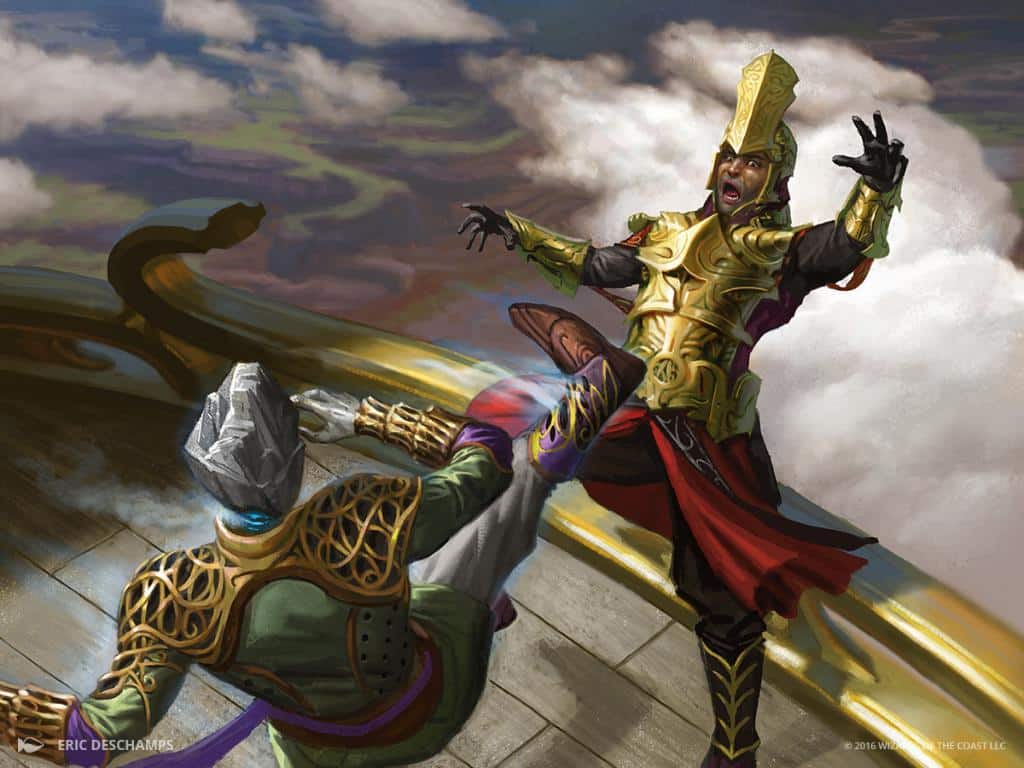Shoving 5e
Published on April 3, 2023, Last modified on June 1st, 2023
Discover the power of shoving in 5e D&D combat. Learn how this often overlooked move can reposition foes, disrupt spellcasters, and give you an edge.

Eric Deschamps - Wizards of the Coast - Fatal Push
Table of Contents
The Shove Action in D&D
Have you ever been so mad at an enemy you wanted to push them off a cliff? Well, in D&D 5e there’s a RAW way to do this! Shoving is a combat action that allows a player to make a special melee attack to push an opponent away from them or knock them prone. This action is often overlooked by players as it seems less effective than attacking with a weapon or casting a spell. However, when used strategically, shoving can be a powerful tool in combat.
Using Shoving in 5e
According to the Basic Rules, you can shove a creature in the following way:
Shoving a Creature
Using the Attack action, you can make a special melee attack to shove a creature, either to knock it prone or push it away from you. If you’re able to make multiple attacks with the Attack action, this attack replaces one of them.
The target must be no more than one size larger than you and must be within your reach. Instead of making an attack roll, you make a Strength (Athletics) check contested by the target’s Strength (Athletics) or Dexterity (Acrobatics) check (the target chooses the ability to use). You succeed automatically if the target is incapacitated. If you succeed, you either knock the target prone or push it 5 feet away from you.
Let’s break this down.
- You can only Shove by taking the Attack action, but characters that get extra attacks can attack with a weapon and Shove in the same turn.
- You can only Shove a creature that is no more than one size larger than you. Seeing as most creatures are Medium size, the largest you can Shove without magical aid is a Large creature. This also can set Small player races, like fairies or halflings, back if they want to be more of a martial character.
- The target must be within your reach, which is 5 feet most of the time.
- The shover must make a Athletics check, but the shovee can make an Athletics or Acrobatics check. This means that STR-based characters will likely be the only builds that want to use this special melee attack.
- If you succeed, you can either move a creature 5 feet away from you or knock it prone. Usually, martial characters will opt for knocking enemies prone because it allows them to gain advantage on attacks. Though, shoving 5 feet away can be useful in cases where you’re trying to push an enemy off a cliff.
The Disadvantages of Being Prone
Being prone when you have a martial fighter looming over you in D&D is never a good thing. They will get advantage on their attacks against you and you have disadvantage on attacks against them, so you’ll want to get out of dodge as soon as possible.
Unfortunately, moving when prone costs 1 extra foot for every foot you move. If you want to stand up from prone, it will take half your movement regardless of how many feet you can move in a turn.
Being prone does have some benefits, however. If you’re being attacked from outside of 5 feet, hitting the deck causes those attacks to have disadvantage against you. It can also help you get to cover to boost your AC or entirely thwart attacks.
How to Shove Strategically
Shoving can be a valuable tool, but it’s often ignored because it doesn’t output damage. Here’s how you can push your martial game to the next level:
Shield Master: This feat allows you to Shove as a bonus action as long as you’re wearing a shield. There is some debate about whether or not you can use the bonus action to Shove between attacks if you have extra attacks. It’s worth discussing with your DM what they rule at their table before picking up this feat to avoid disappointment.
Rune Knight Fighter: This subclass allows you to grow to the Large size, which will enable you to Grapple and Shove Huge creatures. You also get advantage on STR checks, which makes it all the more likely your attempt will succeed.
Barbarian Rage: This ability gives you advantage on STR checks, which when combined with your beefed-out STR score, means you’ll be landing your shoves more often than not.
Use Extra Attacks: Seeing as you can replace one of your attacks with a Shove, using your first attack to Shove your target prone then attacking with advantage for the remaining attacks is a viable strategy. This pays off more when you have advantage on your STR checks (like from the Rune Knight subclass or barbarian’s Rage) and if you have more than two attacks (like a fighter past 11th level). If you really want to go all out and you’re a fighter, you can Shove a creature with your first attack then lay down the pain by using the rest of your attacks and even your Action Surge to net more attacks with advantage.
Shove and Grapple: This is the ultimate combination of strategic special actions. First, you shove a creature prone. Then, you grapple them. Seeing as they are grappled, they can’t take movement. This means that the target can’t simply stand up on their turn. Not only will they make their attacks with disadvantage but all attacks against them have advantage. This is an awesome combo for any STR-based martial build with 2 or more attacks that has other martial party members to help lay the hurt down.
Shove and Run: Need to get out of an enemy’s range so you can move without being opportunity attacked? You can attempt to shove them 5 feet so you’re no longer in their reach. This can be useful if you have multiple attacks and want to move elsewhere and attack, instead of having to spend a whole action disengaging.
Partner Up with a Warlock: Have your warlock buddy cast hex on the target you want to Shove and give them disadvantage on Strength or Dexterity checks (whichever one you think they’ll be relying on more).
Shove Action Mechanical Interactions
Shoving and booming blade: Let’s say you’re an Eldritch Knight who wants to using booming blade then Shove the enemy to trigger the cantrips extra damage. There are ways it can work and ways it won’t work.
Ways it works:
- You hit with booming blade then shove the enemy 5 feet away from you. If they want to close in and make a melee weapon attack on their turn, they will take the extra damage.
Ways it won’t work:
- You hit with booming blade then shove an enemy prone hoping that when they stand up, they take the thunder damage. This doesn’t work because standing up doesn’t constitute as moving.
- You hit with booming blade then shove an enemy 5 feet away hoping that they take the thunder damage because they technically moved. This doesn’t work because the creature didn’t move willingly, which is a caveat in the spell’s wording.
Shoving and flying creatures: Knocking a flying creature prone causes them to fall unless they can hover, this can be a useful way for martial characters to even the playing field. If they have a way to get up to where the flying creature is, they can Shove it back down to the ground and cause falling damage to boot.
Breaking a grapple with shoving: If you have a wizard buddy who’s being grappled, you can attempt to break the grapple yourself by shoving the grappler. If you succeed on your attempt, the grappler is moved 5 feet while your wizard buddy stays put. This will cause the grapple to be broken.
Shoving 5e FAQs
Do you Roll an Attack for Shoving in 5e?
No. While shoving is a special melee attack, it's not a weapon attack. Instead of making an attack roll, you make a contested Strength (Athletics) check against the target's Strength (Athletics) or Dexterity (Acrobatics).
